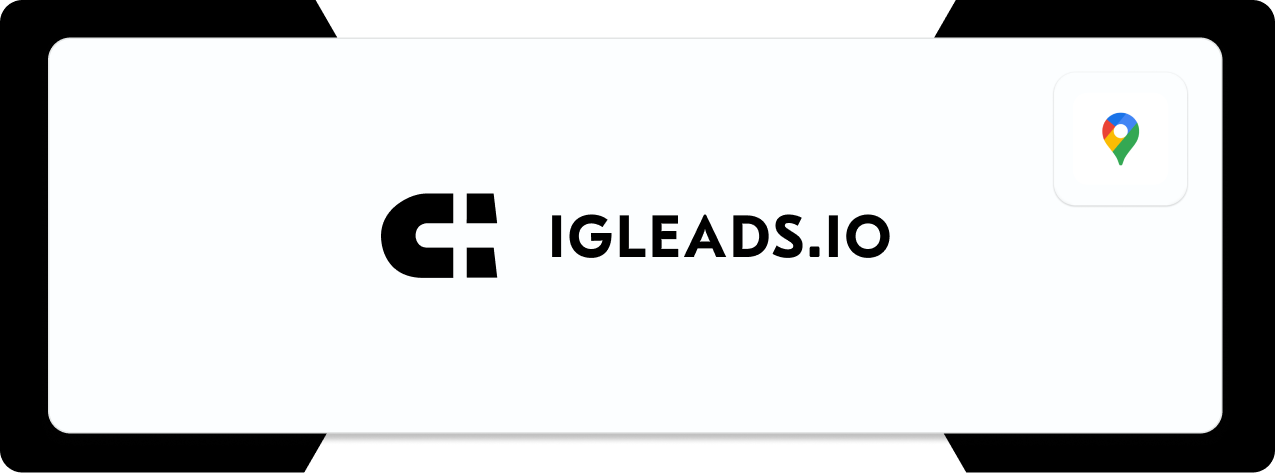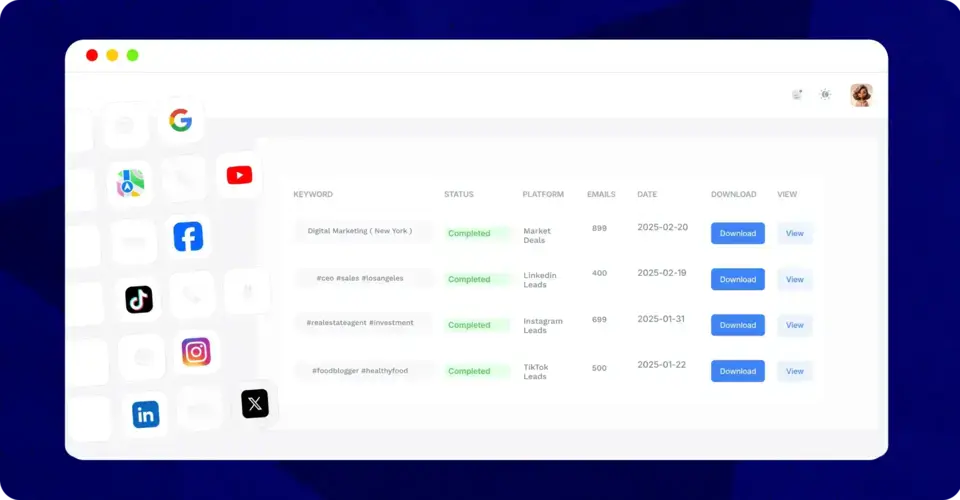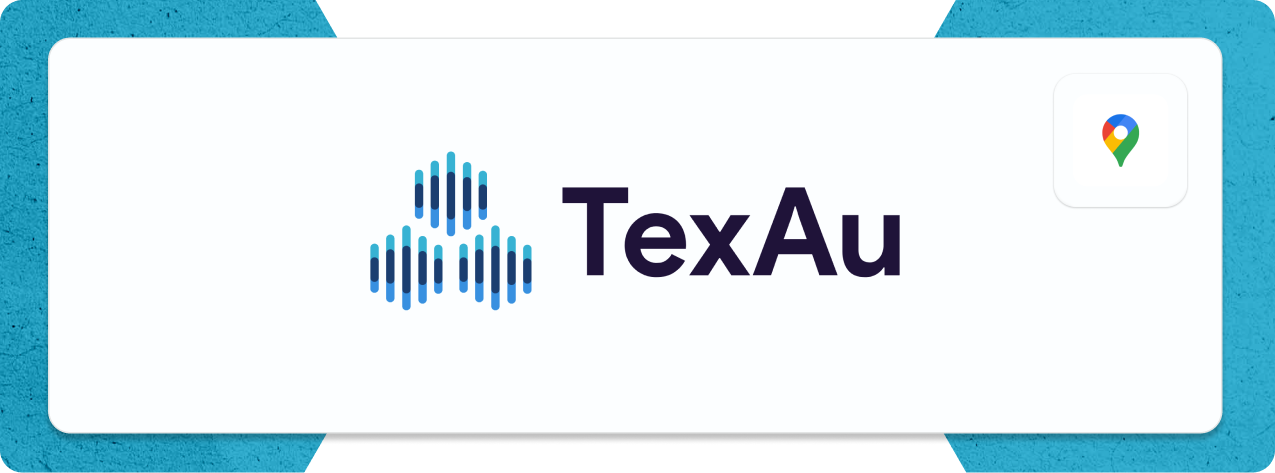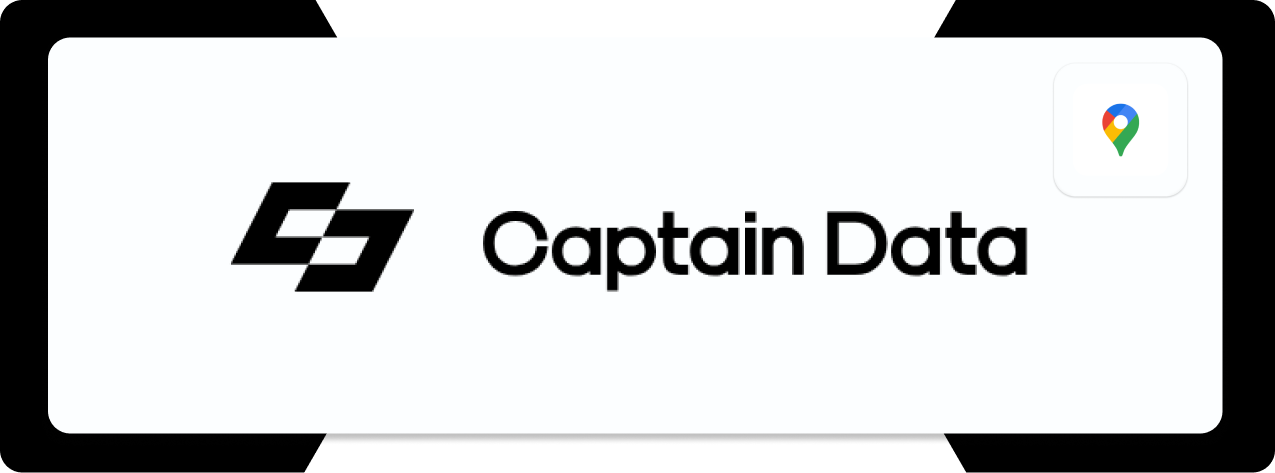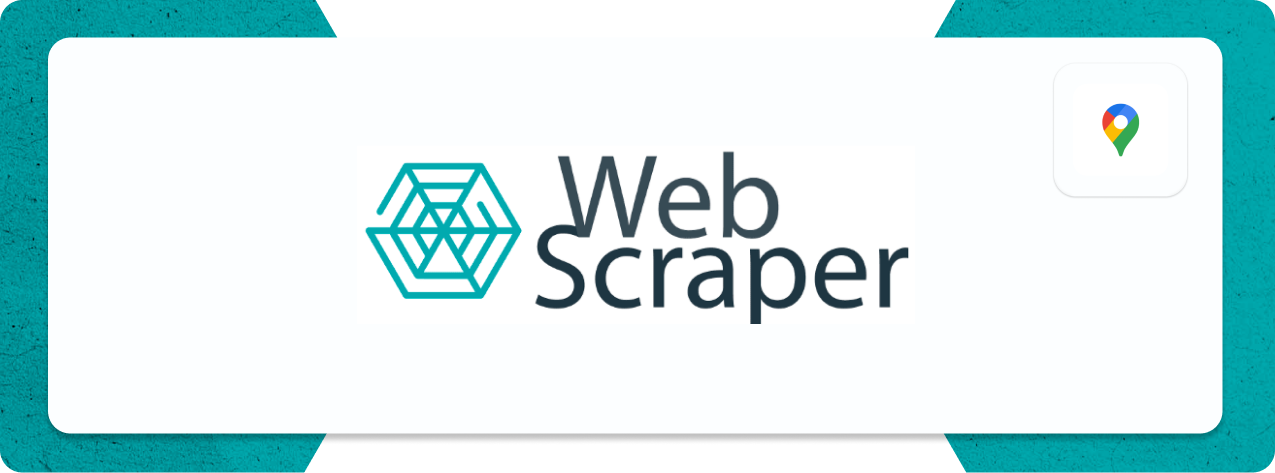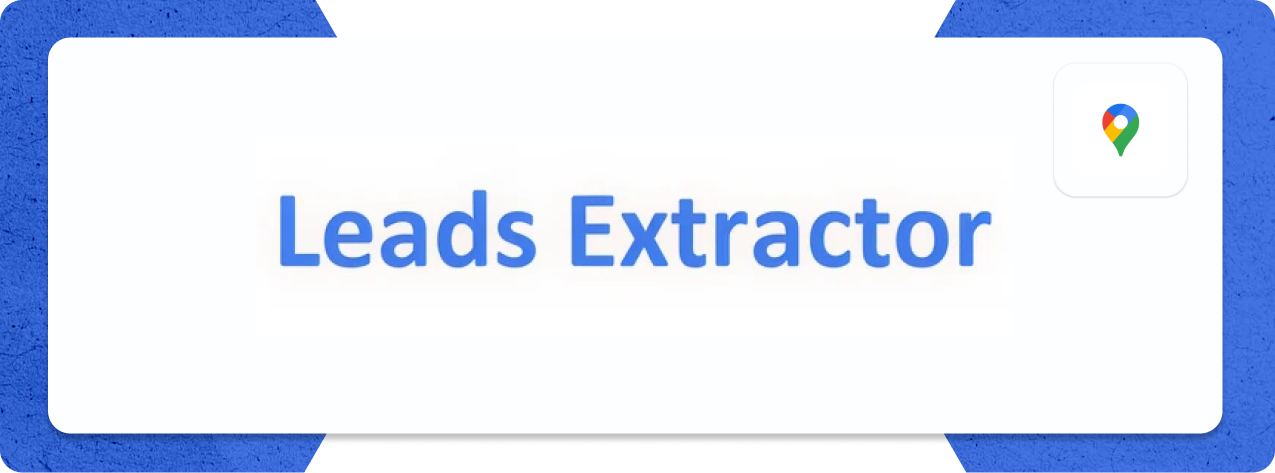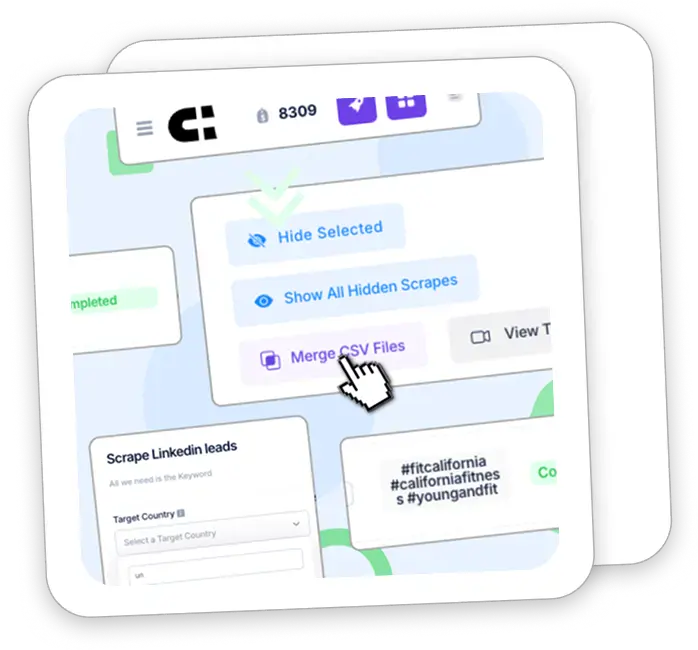How to Scrape Google Maps Emails in 2025: Tools & Guide
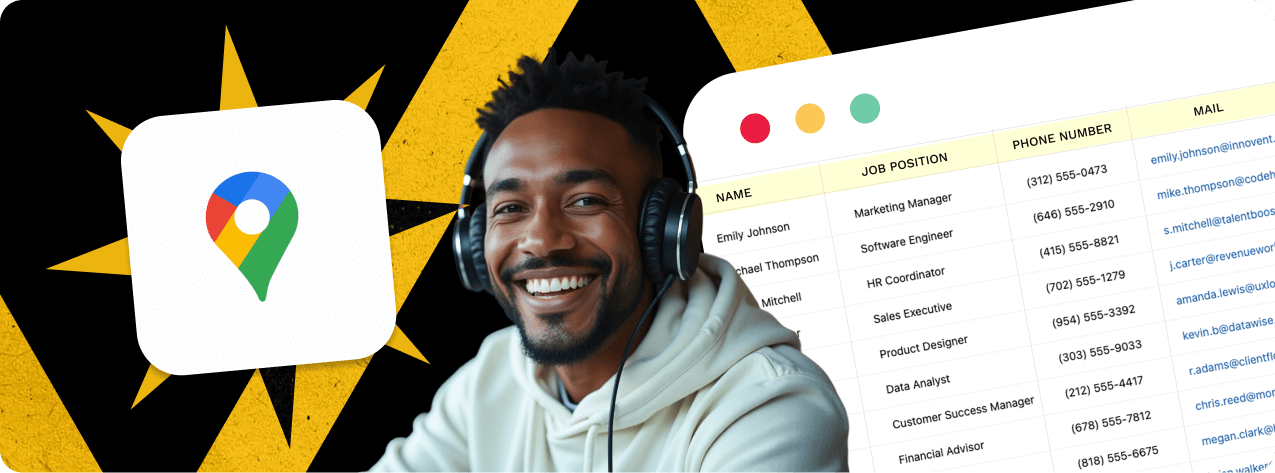
Want to build laser-targeted outreach lists using real business data? Google Maps holds a goldmine of contact info, but collecting it manually can take hours. That’s where a Google Maps email scraper comes in.
With the right tool, you can pull thousands of business listings complete with emails, phone numbers, websites, categories, and more, all in minutes. Whether you’re running cold outreach, selling B2B services, or analyzing local competition, this data can be a serious growth lever.
This guide breaks down how to extract emails from Google Maps manually, how to automate the process with scraping tools, and what to watch out for legally. If you just want the best Google Maps email scraper, feel free to skip ahead.
Let’s dive in.
What is Google Maps email scraping?
Google Maps email scraping is the process of extracting public contact details, like emails, phone numbers, and websites; from business listings on Google Maps.
Instead of opening each business one-by-one and copying down info, scrapers automate the process. You enter a keyword and location (like “photographers in Miami”), and the tool scans relevant listings, pulling structured contact data into a CSV or spreadsheet.
What you get usually includes:
- Business name
- Email address (if publicly listed or linked on their site)
- Phone number
- Website
- Category
- Address
- Reviews or ratings (depending on the tool)
Some advanced scrapers go further by:
- Enriching emails with third-party data
- Scraping directly from linked websites
- Sorting and formatting for outreach tools
Important: These tools only collect data that’s publicly available. Scraping private emails, customer databases, or gated information violates Google’s Terms of Service, and can breach data laws like GDPR or CCPA.
Top 5 Google Maps email scraping tools in 2025
These five tools stand out in 2025 for extracting email and business contact data from Google Maps. Whether you’re a solo marketer, growth hacker, or outbound sales team, you’ll find a solution below that fits your workflow and budget.
| Feature |  |
 |
 |
 |
 |
|---|---|---|---|---|---|
| Key features | • No login or proxies • Keyword + location targeting • CSV export • Multi-platform scraping |
• 180+ automation modules • Google Maps scraping • LinkedIn/email enrichment • CRM sync workflows |
• Sales/CRM integrations • Bulk Google Maps scraping • Clean output for teams • Data enrichment |
• Chrome extension builder • Visual data selection • Works with Maps pages • Exports to CSV or JSON |
• Bulk scraping tool • Built-in email validator • Ready-to-send CSVs • Duplicate detection |
| Pros | • Beginner-friendly • Fast and clean results • Affordable pricing |
• Flexible automation • Multi-step workflows • Works across platforms |
• Great for teams • High-quality output • CRM-ready leads |
• Visual setup • Customizable scrapers • Free plan available |
• Built for sales teams • No coding required • Quick, clean exports |
| Cons | • No advanced filtering • No map heatmap view |
• Requires setup • Learning curve for some |
• Expensive for solo users • Requires integrations |
• More manual setup • Not Maps-specific |
• Limited filtering • Email accuracy may vary |
| Starting price | $59.99/month | $29/month | $399/month | Free + $49/month plans | $25/month |
1. IGLeads – Keyword-based scraping with no login required
Best for: Simple, scalable lead collection across local niches
At IGLeads, we designed our Google Maps email scraper to make lead generation as easy as possible, no login credentials, proxies, or browser extensions needed. Just type in a niche and city, like “wedding planners Boston” or “tattoo studios Barcelona”, and IGLeads pulls all available public contact details.
You’ll get:
- Business name
- Public email address
- Phone number
- Website
- Business category
Once scraping is complete, you can export everything into a clean, deduplicated CSV, ready for upload into your outreach tool or CRM.
How it works:
- Choose “Google Maps Scraper” from your IGLeads dashboard
- Enter a keyword (e.g., “fitness coach”) and a location (e.g., “Los Angeles”)
- Set how many contacts you want, from 50 to 10,000+
- Click start and let the cloud scraper run
- Download your formatted email list in CSV format
We also include an AI keyword assistant that suggests popular search terms based on your niche, perfect for users who don’t know exactly what to target.
Key perks:
- No risk of Google bans, the tool runs server-side
- Fully cloud-based, so you don’t need to keep your browser open
- No account logins or session cookies required
- Works across multiple platforms: Instagram, Facebook, TikTok, and LinkedIn
Pricing:
- Starter – $59.99/month for up to 10,000 emails
- Business – $149.99/month for unlimited scraping across platforms
IGLeads is ideal for marketers, agency owners, sales reps, and local business consultants who want targeted outreach lists without technical setup or bloated contracts.
2. TexAu – Automated workflows for growth teams
Best for: Building full scraping + enrichment chains
TexAu is a powerful automation platform with over 180 built-in workflows (called “spices”), including one for Google Maps. Its Google Maps Search Extractor lets you input a search URL and automatically scrape business names, emails (if available), websites, categories, and more.
But TexAu goes beyond scraping. You can stack steps to build complete outreach workflows:
- Scrape business data → Enrich with LinkedIn + email → Export to Google Sheets or your CRM
- Scrape → Validate emails → Launch cold campaigns
It’s flexible, fast, and runs in the cloud or locally.
Pricing:
- Cloud Starter – $29/month (10 daily tasks)
- Business – $199/month (best for automation workflows)
You’ll need to connect your Google session for some actions. Not fully plug-and-play, but very powerful once configured.
3. Captain Data – Lead workflows for structured outbound teams
Best for: B2B teams syncing scraped leads with CRMs
Captain Data is built for structured lead generation at scale. It’s Google Maps module extracts public business data; names, phones, websites, categories, and lets you enrich, validate, and push it straight into tools like Salesforce, HubSpot, or AirTable.
Use it to:
- Scrape a list of businesses in a target niche
- Match them with LinkedIn or Clearbit data
- Validate emails
- Send clean contacts directly to your CRM
It’s overkill for small one-off jobs, but a dream for growth teams and agencies.
Pricing:
- Starts at $399/month (10,000 automation tasks)
- Custom plans for large teams
Captain Data is all about scale, data quality, and structured workflows. It’s highly visual and designed for serious outbound engines.
4. WebScraper.io – Chrome extension for visual scraping
Best for: Custom setups and users comfortable with DIY
WebScraper.io lets you visually build your own scrapers using a browser extension and sitemap-based logic. It works with Google Maps by targeting the HTML structure of listing pages, letting you extract elements like name, website, and linked emails from business websites.
There’s no automation wizard, you design the flow, but that gives you total control over what’s collected and how.
Pricing:
- Free plan (manual exports)
- Paid starts at $49/month
Great for developers, SEO pros, or anyone needing fine-tuned control over the scraping process. Less ideal for beginners or high-scale automation.
5. LeadExtractor.io – Bulk scraper with built-in cleaning
Best for: Sales reps who need clean email lists fast
LeadExtractor.io focuses on simplicity and speed. You input a keyword and city (e.g., “lawyers Boston”), and it scrapes the related Google Maps listings for names, websites, emails, phone numbers, and addresses.
It automatically removes duplicates, filters out role-based emails (like info@), and outputs a clean spreadsheet ready for cold outreach.
Pricing:
- $25/month for 2,500 credits
- Higher tiers are available for agencies
It’s not the most customizable tool, but it’s fast, easy, and designed for outbound sales teams that care about formatted data and high usability.
Manual vs automated methods
The choice between manually collecting business contact info from Google Maps or using a Google Maps email scraper depends entirely on the size of your project and how scalable you need your workflow to be. Both methods work, but only one holds up when speed, accuracy, and scale matter.
How to manually find emails on Google Maps
Manual email collection is still effective in 2025, especially for small, localized outreach campaigns. The best way to do this is through a desktop browser, since most contact details, including email addresses, are usually listed on the business’s website, not the Google Maps listing itself.
Here’s the typical process:
- Search for your niche on Google Maps (e.g. “florists in Chicago”)
- Click on each business listing
- Check if an email is listed directly in the Maps profile (rare)
- If not, click the linked website
- Visit the contact page or footer to find the email
- Copy/paste the email into your sheet or CRM
In some cases, businesses use email formats like:
Alternatively, you can use Google search operators to narrow results, like:site:maps.google.com “yoga studio miami” gmail.com
This helps surface listings connected to public Gmail or domain-based email addresses.
When to use a Google Maps email extractor like IGLeads
Scraping tools become essential when manual searching just isn’t practical anymore.
Use a scraper if:
- You need more than 30–50 leads per day
- You’re launching a cold email or outreach campaign
- You want the data already formatted in CSV
- You’re working across multiple cities or niches
- You need phone numbers, websites, and emails in one place
Manual collection typically yields 10–20 valid emails per hour.
A cloud-based tool like IGLeads can pull hundreds of leads per hour, deduplicated, sorted, and ready to go.
Some scrapers even cross-check contact info with other platforms to fill in missing data.
Pros and cons of each method
Both manual and automated scraping have their place, it all depends on how many contacts you need, how much time you have, and how clean you want the output to be.
Manual scraping:
Pros:
- Free to do, no tool costs
- Higher targeting precision
- Good for small/local outreach
Cons:
- No formatting or deduplication
- Inconsistent results across niches
- Easy to miss emails buried on websites
Automated scraping with tools like IGLeads:
Pros:
- 500–1000+ leads per day with zero manual work
- Exports data in clean, structured CSVs
- Scales across multiple cities, niches, or categories
- Includes phone, email, website, category, and more
- Saves time and boosts ROI for real outreach campaigns
Cons:
- Some tools can be expensive
- Not all listings have public emails
- Requires care with privacy compliance (GDPR, CCPA)
- Tools with poor filters may return role-based or outdated emails
The bigger your lead list, the wider the gap becomes. If you’re targeting local shops in one city, manual works. If you’re a growth agency, SaaS company, or B2B rep, automation is practically mandatory.
Setting up your Google Maps scraping workflow with IGLeads
Scraping Google Maps emails shouldn’t feel technical or risky. With IGLeads, it’s simple, fast, and 100% cloud-based, no proxies, Chrome extensions, or browser sessions needed.
Whether you’re building a cold email list, researching competitors, or targeting local businesses, IGLeads helps you get clean, usable contact data in just a few clicks.
Step-by-step: How to use IGLeads to extract Google Maps emails
- Log into IGLeads
Head to your dashboard at IGLeads.io and select the Google Maps Scraper tool. - Choose a keyword and location
Enter a search phrase like “plumbers Chicago”, “realtors Miami”, or “digital agency Madrid”.
Not sure what to enter? Use our built-in AI keyword assistant to get niche suggestions automatically. - Select how many leads you want
You can scrape as few as 50 leads or request 10,000+, perfect for testing or scaling. - Click “Start Scraping”
IGLeads runs entirely in the cloud, so there’s no need to keep your browser open or deal with throttling issues. - Download your clean CSV file
Once the job is complete, IGLeads automatically deduplicates, organizes, and formats your results into a ready-to-use spreadsheet, complete with business names, emails, phones, websites, and more.
Check out our short walkthrough video on YouTube.
Best practices and common pitfalls
Google Maps scraping can be a powerful growth lever, but if done carelessly, it can lead to messy data, wasted credits, or compliance issues. Here’s how to keep things smooth, legal, and efficient.
Avoiding rate limits and errors
One of the biggest scraping complaints?
“The data stopped pulling halfway through,” or “I only got partial results.”
This usually happens when:
- You’re scraping through your own IP/browser
- You’re running too many requests too fast
- You’re not respecting platform throttling limits
With IGLeads, this isn’t a problem. Scraping happens server-side, so:
- You don’t need proxies or rotating IPs
- You don’t get blocked mid-job
- You don’t need to manage browser sessions
Still, here are best practices if you’re scraping through other tools:
- Use random intervals, not fixed scraping speeds
- Distribute load if doing large-scale jobs
- Always test a small batch before a full export
Staying compliant with data laws
Privacy laws like GDPR, CCPA, and PECR have become stricter in recent years, especially when working with contact data across borders.
Here’s what you need to know:
- Only scrape publicly available business information
- Never attempt to collect personal or customer data
- Don’t pretend scraped data is “opted-in”, it’s not
- Keep internal records of when and how data was collected
IGLeads is designed to remain compliant by pulling only public, business-facing data, nothing private, nothing behind logins.
If you’re running outbound campaigns, always follow local cold email and consent laws. When in doubt, consult your legal team or use opt-out links in your outreach.
Organizing and storing your data securely
Once you’ve scraped your leads, it’s your responsibility to protect them.
Tips:
- Store lists in encrypted or access-controlled folders
- Don’t mix scraped data with sensitive customer info
- Keep backup copies in secure cloud environments
- Regularly clean out outdated or unused data sets
IGLeads simplifies this by delivering:
- Clean, deduplicated CSVs
- No junk fields or messy formatting
- A consistent column structure that plugs into most CRMs
How to improve email deliverability
Scraping is just step one, actually reaching the inbox is step two.
Here’s how to boost your send success:
- Verify your email list with a validation tool
- Remove catch-all, role-based (info@, support@), and invalid addresses
- Avoid scraping multiple times from the same search, it adds duplicates
- Warm up your sending domain before launching campaigns
IGLeads helps by already formatting and deduplicating your list, but we still recommend running new exports through a verification tool before sending cold emails.
Staying compliant with data laws
We built IGLeads with simplicity and safety in mind, scraping only publicly visible business data from Google Maps. That means we don’t access anything behind logins, personal accounts, or customer databases.
Still, it’s important to keep a few things in mind:
- Only use data that’s publicly available (business emails, websites, phones)
- Don’t treat scraped data as opt-in, it’s for outreach, not newsletters
- Follow local rules around cold emails, especially in the EU, Canada, and California
- When sending campaigns, always offer opt-out links and identify your business clearly
Scraping isn’t illegal, but how you use the data matters. Responsible outreach with clean, targeted lists yields better results and keeps you on the right side of compliance.
IGLeads is optimized to keep your process clean, ethical, and scalable, without bots, browser tricks, or sketchy data access.
The final word on Google Maps scraping tools
Manual scraping works, until it doesn’t. You start by clicking through listings one by one, copying emails, checking contact pages… and before you know it, you’ve lost two hours and collected 12 leads.
It’s slow, inconsistent, and tough to scale.
That’s why we built IGLeads, to automate the grind without complicating the process.
No bots. No proxies. No browser extensions.
Just keyword → city → clean CSV.
Whether you’re:
- Building cold outreach lists
- Prospecting for local businesses
- Scaling agency lead gen
- Targeting service-based niches
- IGLeads makes Google Maps email scraping simple, fast, and structured.
No logins. No scraping knowledge required. Just ready-to-send leads, formatted and filtered.
If you’re serious about growing with outreach in 2025, it’s time to stop copying and pasting, and start pulling data the smart way.
More tools and guides for Google Maps
- Why Scrape Google Maps? Use Cases for Sales, Marketing & SEO
- What is a Google Maps extractor? GMB Scraper, APIs & More
- Free vs Paid Google Maps Scrapers: Which One Should You Use?
- Is It Legal to Scrape Google Maps? What You Should Know
- Best 9 Google Maps Email Scrapers 2025
More step-by-step scraping guides
- How to Scrape Twitter Emails in 2025: Tools & Guide
- How to Scrape TikTok Emails in 2025: Tools & Guide
- How to Scrape Google Emails in 2025: Tools & Guide
- How to Scrape LinkedIn Emails in 2025: Tools & Guide
- How to scrape Facebook emails in 2025: tools & guide
- How to Scrape Instagram Emails in 2025: Tools & Guide
- How to cancel Sales Navigator and switch to a simpler lead tool
- How To Find Someone with Just a First Name and Age
Frequently Asked Questions
Scraping public business contact data is generally legal, but how you use that data matters. Always follow outreach laws like GDPR, CCPA, and CAN-SPAM.
IGLeads is one of the easiest tools to start with. No proxies, no setup, and you can extract emails by keyword and city in just a few clicks.
With tools like IGLeads or LeadExtractor, you can pull hundreds to thousands of leads daily, depending on your niche, region, and filtering options.
No. Scraping tools only collect publicly listed business emails, typically shown on the listing or on linked websites. Private emails aren’t accessible.
Always verify your list, remove duplicates and role-based emails, and use a clean domain. Tools like IGLeads format your data to help you start clean.
